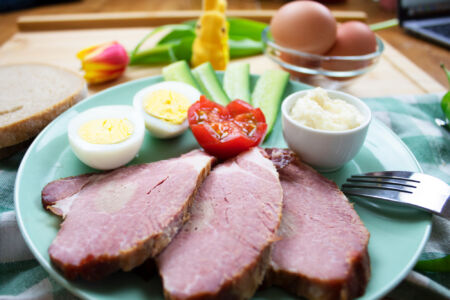Classic Goulash Recipe
Classic Goulash is a national dish of Hungary and a symbol of the country.
Originally, I didn’t want to post the recipe because I assumed everyone could make it, but after browsing the web and reading various recipes, it became clear to me that many people don’t understand what we call real goulash.
The Story Of The Classic Goulash
The name is derived from the Hungarian word gulyás, which means “herdsman.”
However, the word has acquired a second meaning over time, that of a meat dish prepared by herdsmen. The dish’s origins can be traced back to the 17th and 18th centuries, with the first description appearing in 1787.
| Prep time | Cook Time | Rest Time | Total Time |
|---|---|---|---|
| 30 min | 180 min | - | 230 min |
One thing is certain: the Great Hungarian Plain, where stock-riders lived and worked with massive herds of cattle, was the birthplace of goulash. It’s likely that goulash, pörkölt (stew), and paprikash all originally referred to the same meat dish cooked with paprika in a Hungarian kettle over an open fire.
Later, the three terms has separated and each had its own meaning.

Because herdsmen couldn’t putter for long, the cooking method of goulash was simplified, meat, onion, and water were placed in the bogrács (lard was not used in this case), and paprika and salt were added when it was boiling. Herdsmen could do their jobs because they only had to feed the fire and stir the food occasionally. Because goulash was a cross between a stew and a soup, the meat was cooked in more liquid than pörkölt (stew) or paprikash.
The Modern Classic Goulash
The modern goulash is a distant relative of the true goulash, its preparation method to a point is similar to stew, though it is not a stew, but a thick soup. Goulash soup can be made from beef, pork, mutton, or even poultry, exist mushroom, bean and green bean goulash, but exist also fake goulash, which is a meat-free soup.

Each version has its supporters, who all agree on one point: adding flour to thicken the soup or sour cream is not permitted.
Aside from the meat, the soup also includes green pepper, carrot, parsley root, and potato cubes, celeriac and parsley leaves can also be added. Small amount of raw tomato is a modern addition that was not present in the original recipe. The soup is seasoned with paprika, bay leaf, and caraway seeds, and it is supplemented with csipetke (pinched noodle), which are egg noodles.
Before adding them to the boiling soup, small bits of dough are pinched out.
Ingredients
Goulash
Pinched noodle
Instructions
Make The Base For The Classic Goulash
Heat the pork fat in a large pot. Sauté the finely chopped onion until translucent.
Add the mashed or grated garlic and bite cubed beef and fry until all sides are loosing its color.
At this point remove from the heat, sprinkle the paprika evenly over the meat, stir to coat, pour in the water, and return to the heat.
Add the caraway seeds, green pepper (small chopped like the onion), bay leaf, salt, and pepper.
Bring it to boil, then cover and cook over low heat, until almost fork tender.
Meanwhile, prepare the dough for the noodles.
In a mixing bowl, combine the flour, salt and egg and knead into a smooth dough.
The dough should be moldable but not overly soft. If the dough is too dry, add some water.
Pinch off fingernail-sized pieces of dough, place them on a kitchen towel and set aside.Add the cubed carrots and parsley roots to the pot when the meat is nearly done.
When the carrots are halfway done, (make taste test) add the cubed potatoes and pinched noodles (both of them need 20-25 minutes to be tender).
At the end, turn off the heat, and add the fine chopped fresh parsley and celery leafs.Serve immediately with a slice of homemade bread.
Enjoy, Good Appetite!











